Was genau ist
Human Design
und wie wird
es gelesen?
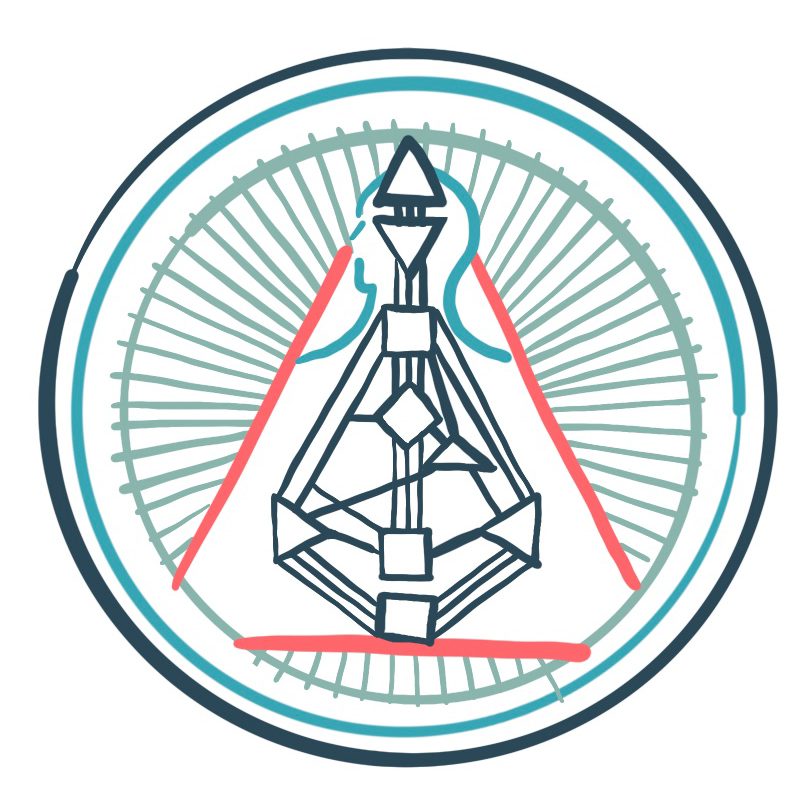
EINE EINFÜHRUNG
Das Human Design System
Human Design verbindet die alten mystischen Lehren (Astrologie, I-Ging, Chakra Lehre, Kebbalah der Lebensbaum) und die moderne Wissenschaft (Physik, Genetik, Biochemie). Mit den Geburtsdaten wird durch die astrologische Berechnung die Planetenpositionen ermittelt und in das Human Design Rave Mandala übertragen.
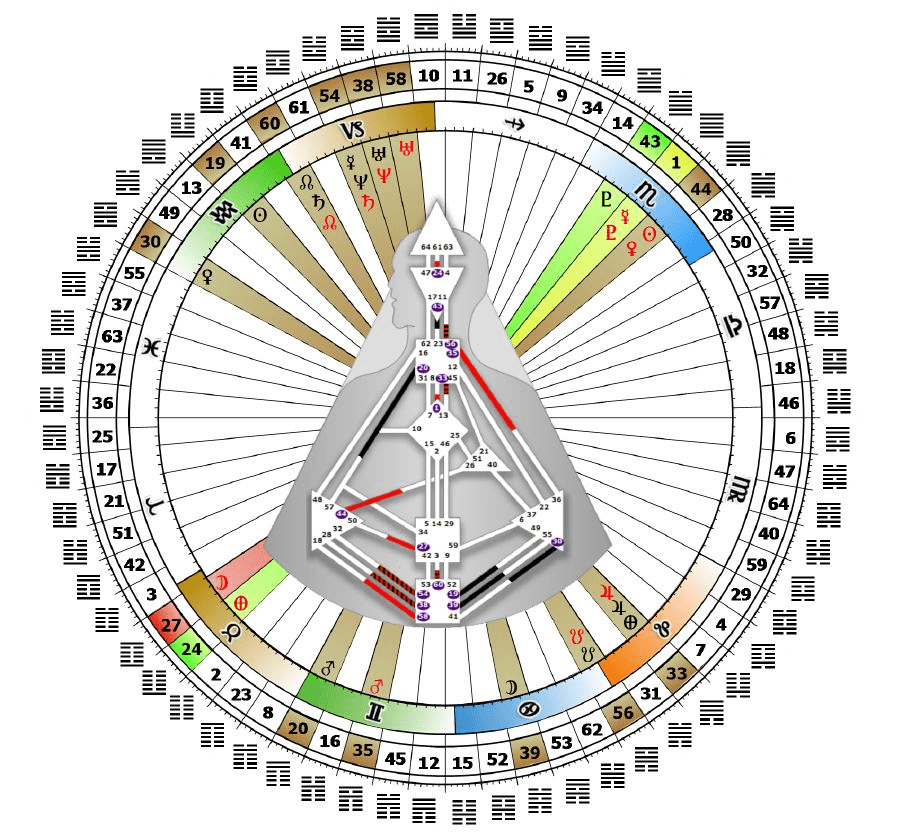
Im Human Design erhältst du mit deinem Reading zunächst ein theoretisches Wissen über dich. Die Aufgabe ist es, dieses Wissen nicht nur mental zu verstehen, sondern eine innere Weisheit draus zu machen und nach den ganz eigenen Mechaniken zu leben. Gewisse Dinge in uns laufen einfach ab, ohne Im Human Design erhältst du mit deinem Reading zunächst ein theoretisches Wissen über dich
Die Aufgabe ist es, dieses Wissen nicht nur mental zu verstehen, sondern eine innere Weisheit draus zu machen und nach den ganz eigenen Mechaniken zu leben. Gewisse Dinge in uns laufen einfach ab, ohne dass wir dabei einen großen Einfluss darauf haben und das sind unsere unbewussten Mechaniken. Es gibt auch bewusste, die wir viel leichter wahrnehmen können. Zudem gibt es noch die Konditionierungen von außen, die oftmals unser Leben bestimmen.

Das Human Design System
Die Vier Typen
Manifestor
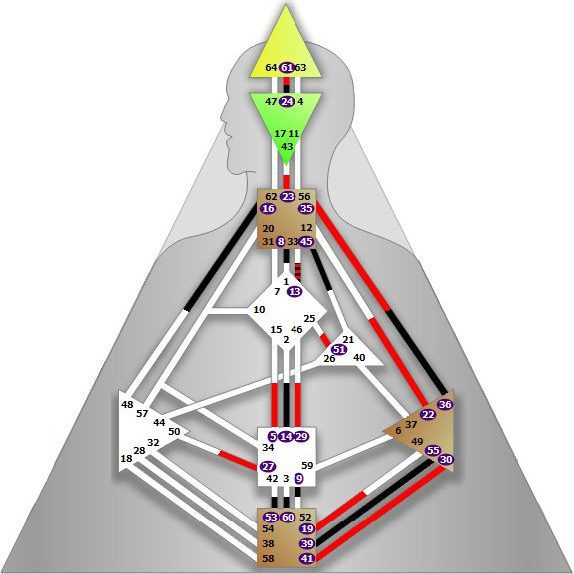
STRATEGIE: Kann aus sich heraus handeln
Generator

ERKENNBAR: Das Sakral-Zentrum ist definiert
STRATEGIE: Wartet und reagiert auf das Leben
Projektor
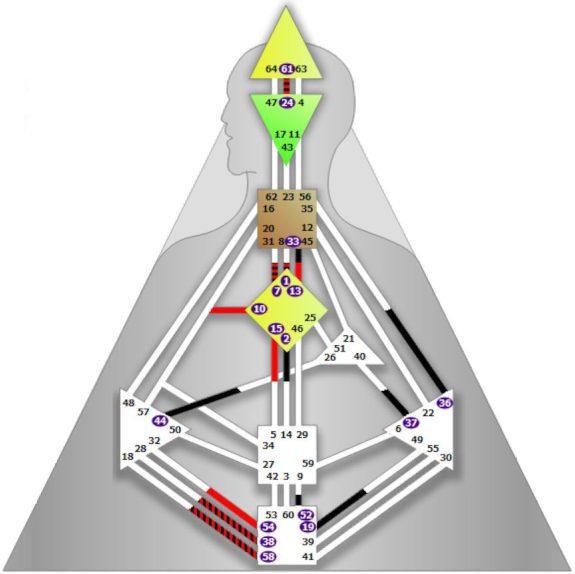
ERKENNBAR: Sakral offen und kein Motor mit der Kehle verbunden
STRATEGIE: Auf die Einladung warten
Reflektor
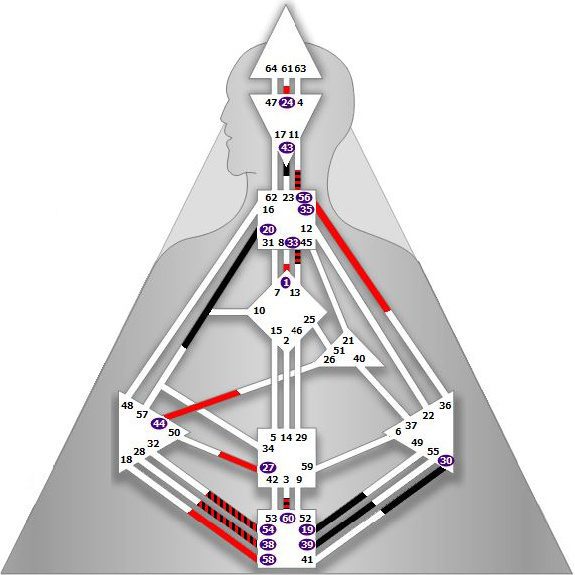
ERKENNBAR: Alle Zentren sind weis und nicht definiert
STRATEGIE: Einen Mondzyklus lang warten
Rave Chart
Die Körpergrafik (Rave Chart) ist die visuelle Essenz des Human Design Systems. Sie fasst die gesamten Informationen des Human Design in Form einer grafischen, intuitiv erfassbaren Synthese zusammen.
Das Rave Chart ist eine klare und einfache Darstellung der Struktur des Menschen. Jeder Punkt in der Grafik hat eine feste Funktion in Beziehung zum übrigen Körper. Wie in einem Schaltplan werden die vernetzten Informationen sichtbar und vermitteln so tiefe Einblicke in unsere inneren Regelkreise.
Jedes Rave Chart beinhaltet: Zentren, Tore und Kanäle
Die Verbindungen zwischen den Zentren werden Kanäle bezeichnet und eine definierte (farbige) Verbindung entsteht, wenn die beiden Tore eines Kanals definiert sind. Ist ein Kanal definiert, werden die Zentren, die durch den Kanal verbunden sind, definiert.
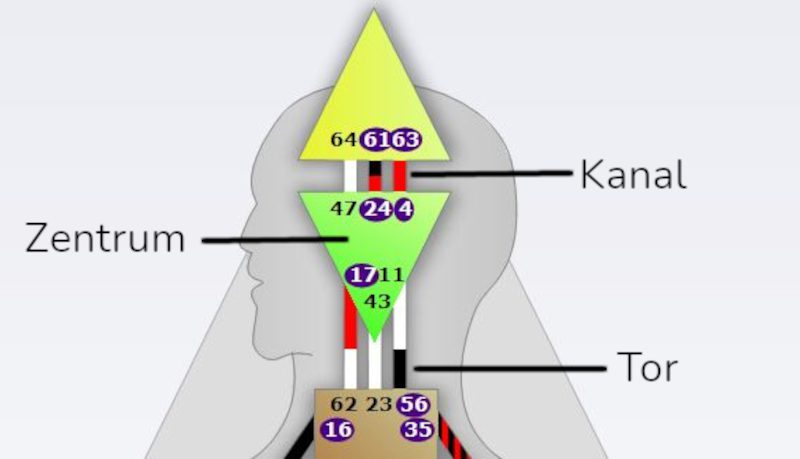
Zentren
Die Zentren des Human Design Systems© gehen auf die alten indischen Chakrenlehren zurück. Jedem Zentrum sind Funktionen zugeordnet, die entweder im Bauplan fixiert sein können, oder die „offen“ also nicht fixiert sind. Welche Zentren definiert oder offen sind und wie sie miteinander in Verbindung stehen, lässt im Human Design unter anderem auch die vier verschiedenen Grundtypen erkennen.
Dies ist der Bereich einer Persönlichkeit, der für Stress und Adrenalin steht. Es ist einer der 4 Körpermotoren. Hier zeigt sich, ob und auf welcher Ebene jemand offen und empfänglich für Stress ist oder welche existentiellen Kräfte ihn beständig antreiben.
Dies ist der Bereich einer Persönlichkeit, der für Körperkraft und Sexualität steht. Es ist einer der 4 Körpermotoren. Hier zeigt sich, ob und auf welcher Ebene jemand beständige Körperkraft zur Verfügung hat. Dieses Zentrum ist bei ca. 70 % der Menschen aktiviert, und bedingt dadurch den Typ des Generators.
Dies ist der Bereich einer Persönlichkeit, der für Emotionen und Gefühle steht. Es ist einer der 4 Körpermotoren. Hier zeigt sich, ob und auf welcher Ebene jemand offen und empfänglich für die Emotionen anderer Menschen ist oder welche Art von Emotionen beständig bei ihm ablaufen.
Dies ist der Bereich einer Persönlichkeit, der für Willensstärke steht. Es ist einer der 4 Körpermotoren. Hier zeigt sich, ob und auf welcher Ebene jemand beständige Willenskraft besitzt.
Dies ist der Bereich einer Persönlichkeit, der für instinktive und intuitive Wahrnehmung steht. Hier zeigt sich, ob und auf welcher Ebene jemand verlässliche und spontane Intuition zur Verfügung hat und wie die grundsätzliche Funktionsweise seines Immunsystems abläuft.
Dies ist der Bereich einer Persönlichkeit, der für Identität, Richtung und Liebe steht. Hier zeigt sich, ob und auf welcher Ebene jemand offen für verschiedene (Aus-) Richtungen in seinem Leben ist oder ob er ein oder mehrere bestimmte Themen von Richtung und Liebe verlässlich in sich trägt.
Dies ist der Bereich einer Persönlichkeit, der für Sprache, Manifestation und Handeln steht. Hier zeigt sich, ob und auf welcher der vielen Ebenen jemand sprechen und/oder handeln kann. Die vielfältigen Verbindungsmöglichkeiten zu den anderen Zentren spielen hier eine besonders große Rolle und sind zum Teil auch mit dem Typ verbunden.
Dies ist der Bereich einer Persönlichkeit, der für die intellektuelle Wahrnehmung, für unseren Verstand steht. Hier zeigt sich, ob und auf welcher Ebene jemand offen und empfänglich für intellektuelle Information ist oder ob er beständig auf eine bestimmte Art denkt.
Dies ist der Bereich einer Persönlichkeit, der für mentale Anregung und Inspiration steht. Hier zeigt sich, ob und auf welcher Ebene jemand offen für Anregungen von außen ist oder ob jemand Anregungen immer auf eine ganz bestimmte Art verarbeitet.
Definition
Sind in der Körpergrafik 2 oder mehr Zentren miteinander durchgehend verbunden, spricht man von einer „Definition“.
Einfache Definition

ca. 41 %
Diese Menschen fühlen sich innerlich als Ganzes, da sie keinen Split in sich tragen. Sie brauchen keine anderen Menschen, um sich als „Ganzes“ wahrzunehmen wie andere mit einem Split.
Zweifache Definition

ca. 46 %
Diese Menschen haben sozusagen „zwei Seelen in einer Brust“. Das heißt zwei Lebenskräfte in sich, die unabhängig voneinander agieren und sich nach Vervollständigung sehnen. Wichtig ist hier, nicht in Abhängigkeiten durch andere Menschen zu kommen.
Dreifache Definition
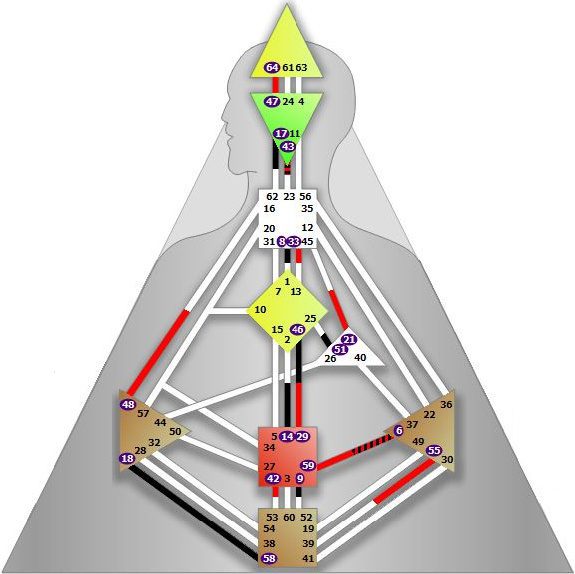
ca. 11 %
Diese Menschen haben sozusagen „drei Seelen in einer Brust“. Das heißt drei Lebenskräfte in sich, die unabhängig voneinander agieren. Sie brauchen viele Menschen um sich, aber brauchen den andern nicht so sehr wie die zweifache Spaltung. Erblühen tun diese Menschen, wenn nur zwei Definitionsbereiche durch andere Menschen verbunden werden.
Vierfache Definition

ca. 1 %
Diese Menschen haben sozusagen „vier Seelen in einer Brust“ und sind sehr selten. Für diese Menschen gilt sich ihrer Besonderheit klar zu sein und ihr manchmal inneres Chaos zu akzeptieren und lieben zu lernen. Es können nur ein bis zwei Zentren offen sein und hier gilt es große Vorsicht an den Tag zu legen, weil hier das größte Potenzial für Konditionierung besteht.
Keine Definition

ca. 1 %
Diese Menschen haben keine definierten Zentren und sind somit Reflektoren. Ihre Definitionen sind abhängig vom Mondzyklus und anderen Menschen.
Profil
Das Profil bestimmt auch den Winkel: Rechter Winkel‚ bedeutet eine grundsätzliche Ausrichtung nach Innen. Im Human Design werden diese Profile als persönlich bezeichnet. Linker Winkel‚ bedeutet eine grundsätzliche Ausrichtung nach Außen. Im Human Design werden diese Profile als transpersonal bezeichnet. Die genau dazwischen stehende Juxtaposition bedeutet eine besondere Geradlinigkeit. Im Human Design werden diese Profile als fixiert bezeichnet.
Ca. 15 % der Menschheit Der Forscher von der Persönlichkeit geht den Dingen auf den Grund, um ein solides Fundament zu erstellen und mit dem Wissen zu einer Autorität zu werden. Der Märtyrer ist auf der körperlichen Seite und bringt diese Menschen oftmals in für andere „unmögliche“ Dinge hinein. Sprüche wie „Das schaffst auch nur du“ und das ist gut so und auch wichtig.
Ca. 2 % der Menschheit Der Forscher von der Persönlichkeit geht den Dingen auf den Grund, um ein solides Fundament zu erstellen und mit dem Wissen zu einer Autorität zu werden. Der Opportunist auf der körperlichen Eben zieht den Menschen nach draußen zu andere Personen, um Freundschaften zu knüpfen und ein Netzwerk zu bilden. Aus dem Netzwerk kommen die Gelegenheiten für diese Menschen und daher bietet ein großes Netzwerk mehr Möglichkeiten.
Ca. 15 % der Menschheit Der Einsiedler in der Persönlichkeit ist eher zurückgezogen und muss gerufen werden. Zudem ist er auch ein Naturtalent, was er selbst oft nicht wahrnimmt, aber die anderen und so werden die unterschiedlichsten Dinge auf ihn projiziert. Der Opportunist auf der körperlichen Ebene zieht den Einsiedler nach draußen, um Freundschaften zu knüpfen und ein Netzwerk aufzubauen. Aus dem Netzwerk zieht er die richtigen Gelegenheiten für sich raus.
Ca. 2 % der Menschheit Der Einsiedler auf der persönlichen Seite und der Ketzer auf der körperlichen Seite sind beides projizierende Linien und somit wird sehr oft auf diese Person projiziert. Sei es eine Aussage oder wenn die Person sich in ihre Einsiedelei zurückzieht, kann es die Menschen in ihrer Umgebung dazu bringen, auf sie zu projizieren und es als Ketzerei ansehen. In dem Profil kann bewusst wahrgenommen werden, wann sich das Gefühl einstellt, sich zurückziehen zu wollen.
Ca. 15 % der Menschheit Der Märtyrer in der Persönlichkeit will die Dinge ausprobieren und lernt aus Fehler. Dabei stolpert er in alle möglichen Situationen und der ketzerische Körper löst dabei oftmals noch Empören aus. Beide Linien sind mutative Linien und haben so das Potenzial wach zu rütteln, die Dinge infrage zu stellen und eine Weiterentwicklung anzustoßen.
Ca. 2 % der Menschheit Das Rollenvorbild durchläuft 3 Lebensphasen. Bis 30 leben sie das Leben eines Märtyrers mit Versuch und Irrtum. Von 30 bis 50 ist die 2. Phase, in der sie sich zurückziehen. Sie werden zum Beobachter der Geschehnisse und reflektieren das Erfahrene. Mit 50 kommen sie zurück in die Welt als Rollenvorbild, wenn sie ihre Hausaufgaben während des Rückzuges gemacht haben. Besonders wichtig für 6/3 ist, dass in den ersten 30 Jahren eine 3/3 sind und somit heißt das Chaos und Aktion im Leben. Sie krachen in alles rein, was nur geht. Also heißt es Vorsichtsmaßnahmen zu treffen. Ihr Körper hat nicht den Schutz einer 3. Linie, daher müssen diese Menschen in den ersten 30 Jahren besonders acht auf ihren Körper geben.
Ca. 15 % der Menschheit Das Rollenvorbild durchläuft 3 Lebensphasen. Bis 30 leben sie das Leben eines Märtyrers mit Versuch und Irrtum. Von 30 bis 50 ist die 2. Phase, in der sie sich zurückziehen. Sie werden zum Beobachter der Geschehnisse und reflektieren das Erfahrene. Mit 50 kommen sie zurück in die Welt als Rollenvorbild, wenn sie ihre Hausaufgaben während des Rückzuges gemacht haben. Der Körper wird hier viel durch Versuch und Irrtum in den ersten 30 Jahren lernen und gib gut auf sich acht. Der Opportunist auf der persönlichen Seite wird Freundschaften knüpfen und ein Netzwerk aufbauen, um daraus günstige Gelegenheiten zu bekommen.
Ca. 2 % der Menschheit Dieses Profil ist der Verbindungspunkt zwischen den Profilen mit persönlicher Bestimmung und denen mit transpersonalem Karma. Hierbei handelt es sich um Menschen, die eine fixierte Art haben durchs Leben zu gehen wie ein Zug auf einer Schiene und es ist wichtig für sie, sich auf den Schienen zu bleiben. Auf der persönlichen Seite sind sie der Opportunist, der Freundschaften knüpft und ein Netzwerk aufbaut, um daraus günstige Gelegenheiten zu bekommen. Der Forscher auf der körperlichen Ebene muss die Dinge ergründen, um Sicherheit im Leben zu bekommen.
Ca. 15 % der Menschheit Der Ketzer „muss“ hinaus in die Welt und mit anderen Menschen in Verbindung gehen, um zu ketzen und mit dieser Ketzerei Mutation auszulösen. Für diese Veränderung ist eine solide Grundlage und Forschung nötig, ansonsten wird die Ketzerei nicht erst genommen und der gute Ruf ist dahin. Die 5. Linie „muss“ hinausgehen in die Welt und ist für andere da. Der Forscher auf der körperlichen Ebene zieht diese Personen immer wieder in den Rückzug.
Ca. 2 % der Menschheit Der Ketzer auf der persönlichen Seite und der Einsiedler auf der körperlichen Seite sind beides projizierende Linien und somit wird sehr oft auf diese Person projiziert. Sei es eine Aussage oder wenn die Person sich in ihre Einsiedelei zurückzieht, kann es die Menschen in ihrer Umgebung dazu bringen, auf sie zu projizieren und es als Ketzerei ansehen. Der Körper verlangt hier oftmals nach Rückzug.
Ca. 15 % der Menschheit Das Rollenvorbild durchläuft 3 Lebensphasen. Bis 30 leben sie das Leben eines Märtyrers mit Versuch und Irrtum. Von 30 bis 50 ist die 2. Phase, in der sie sich zurückziehen. Sie werden zum Beobachter der Geschehnisse und reflektieren das Erfahrene. Mit 50 kommen sie zurück in die Welt als Rollenvorbild, wenn sie ihre Hausaufgaben während des Rückzuges gemacht haben. Der Körper zieht die Menschen immer wieder in den Rückzug, ganz besonders während der 2. Lebensphase.
Ca. 2 % der Menschheit Das Rollenvorbild durchläuft 3 Lebensphasen. Bis 30 leben sie das Leben eines Märtyrers mit Versuch und Irrtum. Von 30 bis 50 ist die 2. Phase, in der sie sich zurückziehen. Sie werden zum Beobachter der Geschehnisse und reflektieren das Erfahrene. Mit 50 kommen sie zurück in die Welt als Rollenvorbild, wenn sie ihre Hausaufgaben während des Rückzuges gemacht haben. Besonders wichtig für 6/3 ist, dass in den ersten 30 Jahren eine 3/3 sind und somit heißt das Chaos und Aktion im Leben. Sie krachen in alles rein, was nur geht. Also heißt es Vorsichtsmaßnahmen zu treffen.
Inkarnationskreuz
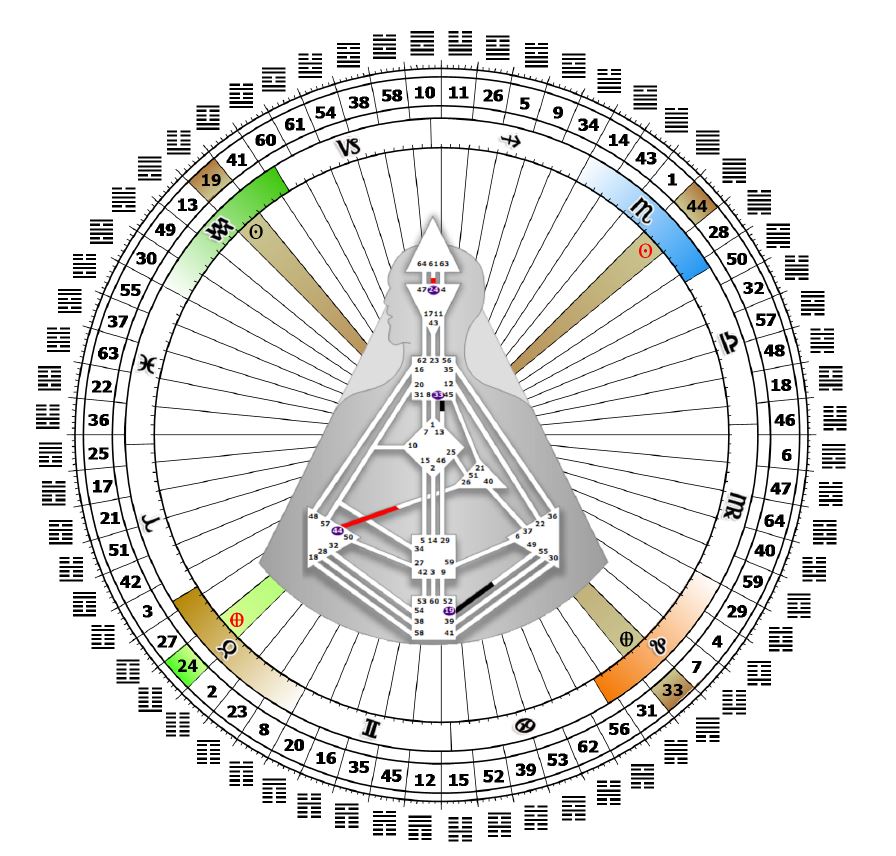
Autorität
Die innere Autorität ist ein Mechanismus eines jeden Menschen, der zu verlässlichen und authentischen Entscheidungen führt. Dabei sollten jedoch der Typ und die Strategie berücksichtigt werden. In einem Reading erfährst du Genaueres über deine Autorität. Hier ist ein Überblick mit allen möglichen inneren Autoritäten.
1. Autorität im Solarplexus-Zentrum
Du bist ein emotionaler Mensch und solltest dir auf jeden Fall Zeit lassen für eine Entscheidung.
2. Autorität im Sakral-Zentrum
Dein Bauchgefühl sagt dir, wofür du deine Körperenergie nutzen solltest oder nicht.
3. Autorität im Milz-Zentrum
Deine Körperwahrnehmung sagt dir im jetzt was zu tun ist oder nicht.
4. Autorität im Ego-Zentrum
Du triffst deine Entscheidungen aus dem Willen, dieser kommt vom Körper und nicht vom Verstand.
5. Autorität im G-Zentrum
Hör dir zu, was dein Selbst in einem Gespräch erzählt. Das gibt dir die Entscheidung wie ein Hauch, der flüstert.
Äußere Autorität
Eine äußere Autorität ist der Fall, wenn keines der oben genannten Zentren für eine innere Autorität definiert ist. Für Menschen mit einer äußeren Autorität gilt es mindestens 28 Tage zu warten, bevor eine Entscheidung getroffen werden sollte.
